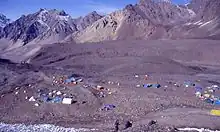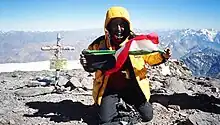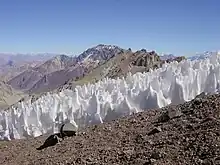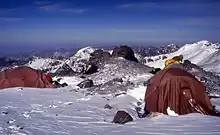Aconcagua
highest mountain in both the Southern and the Western Hemispheres (6962 m)
Aconcagua is a mountain in the Mendoza province of Argentina, not far from the Chilean border.
.jpg.webp)
Understand
At 6,961 m (22,837 ft), Aconcagua is the highest mountain outside of Asia. It's also one of the Seven Summits and part of the Aconcagua Provincial Park, founded in 1983. The name comes from Quechua and means "white guard" or "stone guard".
Aconcagua has the second highest topographical prominence in the world, the closest higher mountain is 16,520 km (10,270 mi) away.
History
The first official ascent took place on 14 January 1897 by the Swiss mountain guide Matthias Zurbriggen, on his fifth attempt. The rich English adventurer Edward Fitzgerald whom he was guiding didn't reach the summit himself due to health problems.
In 1947 a guanaco skeleton was found on the ridge connecting the main and the southern summit, and in 1985 a well preserved mummy was found on the southwestern ridge at an altitude of 5200 m. These discoveries support the hypothesis that Aconcagua (just like other mountains in the Andes) were summited by native people before the arrival of the Europeans.
Landscape
The mountain is situated in a high-altitude desert with little water and vegetation. Because of this, there different rocks composed of different minerals in different colors (green for copper, red for iron) are visible. Other things you can see are remains from the mining industry.
Flora and fauna
Climate
The best time to visit Aconcagua is the Austral summer from mid-December to late March.
There are big differences between day and night temperatures and weather conditions change frequently. The only constant thing is the strong winds, therefore you should practice setting up your tent before beginning the expedition. Anything with a large surface that the wind could catch needs to be tied up — bring a lot of rope.
The nearby Pacific Ocean has an influence on the weather, and storms coming in from there can very quickly create extreme weather conditions. This is called the Viento Blanco ("white wind"), and can turn sunny and calm mountain weather into a thunderstorm with heavy snowfall and hurricane-force winds in just a few hours.
Get in
Mendoza is a popular gateway for expeditions to Aconcagua, and from there you proceed to either starting point near the mountain. Puente del Inca and Punta de Vacas are both at the highway between Mendoza and Los Andes on the Chilean side.
- 🌍 Puente del Inca (2720 m), the "Bridge of the Incas" (47 m) is a world famous natural bridge. Nearby there's a hot spring rich in sulfur, though it may be destroyed by landslides. Starting point in the Horcones Valley.
- 🌍 Punta de Vacas, the starting point is in the eastern base camp Plaza Argentina, which is also a hamlet and ski resort at Tupungato (6550 m), in the South American summer there's not much going on here.
Fees and permits
Permits for the full-day trek in the Anconcagua Provincial Park are only sold until 11:30 in the morning, so ensure you arrive at the park visitor's center before 11:30am. Prices vary depending on your nationality (foreigners need to pay in hard currency, ie. USD) and whether you are trekking independently (slightly more expensive) or with a company.
Get around
The base camp

The base camp, 🌍 Plaza de Mulas, is about 4300 m above sea level, and even if you go only that far, you should've tried out being at similar altitudes beforehand. For a fit hiker, the camp is a two-day trek away, overnighting in camp Confluencia (where you can obtain water from a stream). There are mules for rent to carry your equipment up to the base camp.
The hike starts in Los Penitentes, that is Puente del Inca. From there, it is about an hour's walk north (this section can alternatively be driven by 4WD) to the entrance to the park (controlled by park rangers). From there, the walk leads through the Horcones Valley up to Plaza de Mulas. The total distance is 35 km, and entails a 1560 m of gain of altitude. No matter how fit you are, it will entail at least ten hours of walking. To acclimatize, spend two days for walking up to the camp (four and five to eight hours).
On the second day you will need to cross a glacier stream from west to east. Do this as early as possible, because the closer you get to the camp, the steeper (and more rapid) the stream becomes. The glacier stream will also be your water source in the basis camp, and due to the mineral content of this water, bring anti-diarrhea medication.
About 15 minutes on foot from the base camp is the Hotel de Plaza de Mulas with basic medical facilities (including remedies for altitude sickness).
During the season there are 200-400 people in the base camp any given day, during the whole season a total of 4000.
Summiting

Aconcagua is almost 7000 m high, and as such climbing to the 🌍 summit should be attempted only by fit climbers with experience with altitudes of this caliber. It's definitely recommended to first climb a middle 5000s in order to get acclimatized before attempting to summit this mountain. Just 20% of the attempts are successful and the accident rate is far above Mount Everest's!
There are several routes to the summit, listed below from the easiest to the most difficult. Expeditions by tour companies usually take either of two easiest routes.
- The normal route is usually ice-free during the high season. This rather monotonous route goes from Plaza de Mulas over Nido de Cóndores, Camp Berlin, through the difficult Canaleta scree (33° slope, about 400 m length) on to the saddle between the northern and southern peaks and from there to the summit. Usually climbers use two or three high altitude camps to reach the summit this way. Much of the section from the base camp to the saddle is visible from the base camp.
- The false Polish route begins at the base camp Plaza Argentina at the eastern side of the mountain. Plaza Argentina itself is at an altitude of about 4200 m, and it takes three days to get there from Punta de Vacas through the Rio de las Vacas valley. The false Polish route joins the polar route at 6200 m altitude, circumventing the glacier climb of the Polish route. It's possible to descent using the normal route, the so called Polish traverse.
- The Polish route was first climbed in 1935 by a Polish expedition. It goes along the eastern side of the mountain including a 800 m high wall, slopes as steep as 55° and glacial climbing, and is regarded as the second most challenging route to the summit.
- The Pared Sur goes up the southern side of the mountain. Being in the Southern Hemisphere it means it's the side of the mountain with the least sunshine (as the northern sides of mountains in the Northern Hemisphere), and features 3050 m of ice and weak rocks. First ascended in 1954 by a French team over eight days, this has ever since been regarded as one of the most difficult climbs in the world. Also, some extra paperwork is needed to be allowed to climb this route.
See

- Penitentes (around the base camp). Ice formations that can be several meters high have emerged due to the strong sun radiation in the high altitude regions near the Equator. (updated May 2019)
- Mountaineer cemetery (in Puente del Inca). The final resting place for the victims of the mountains. (updated May 2019)
Do
Buy
- Casa Orviz, ☏ +54-261-4251281. Mountaineering equipment store in Mendoza. (updated May 2019)
Eat
Except for the rather expensive hotel near the base camp, the last restaurants before the climb (and first after) are in Puente del Inca and Punta de Vacas. In the national park itself there are no places to stock up on provisions. Therefore, expect the normal "mountaineer fare", heated on portable stoves.
Drink
Sleep

- Guesthouse Puente del Inca. Mountaineer guesthouse. (updated May 2019)
- Hotel de Plaza de Mulas. (updated May 2019)
Lodging
Camping
Backcountry
Stay safe
There are reports of mountaineers having found their food and equipment depots looted. If you leave things behind for some time such as at a high camp, make an agreement with other climbing groups to watch each others belongings.
Stay healthy
Drinking water is obtained from the streams, originates from molten ice and snow, and should be boiled before drinking. Due to the altitude, the boiling point of water is lower (for instance at the base camp it's +86°C), so a good alternative is to use disinfection pills. There were as of January 2009 no hygienic issues with the water, but the water has a high magnesium content which has a laxative effect. The local doctors recommend using anti-diarrheal medicine to cope with this.
According to the park rules, you need to take your trash with you out of the park. This also includes your feces, and plastic bags are handed out at the park entrance for this purpose. Above the base camp the park rangers aren't really able to enforce this rule, moreover it doesn't apply to mules. The latrines next to the main routes are notable from far away by the smell.
Altitude sickness is a real risk, consult that article for details.